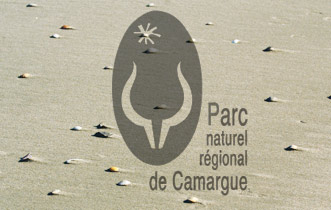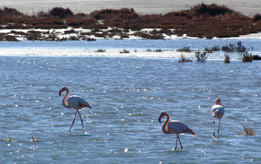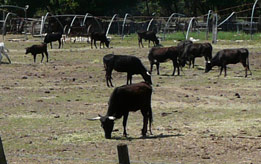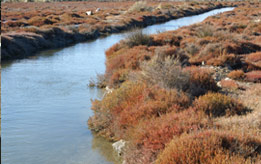- Home
- The agency
- Discover Provence
- Sustainable tourism
- Our offers
- Owners

The Regional Natural Park of Camargue was created in 1970. It is located at the western end of the department of the Bouches-du-Rhone.
The Park of the Camargue is located between the confined branches of the Rhone, the Little Rhone and the Big Rhone, extends to the East up to the plains of La Crau, to the West up to Aigues-Mortes and to the North up to Beaucaire.
At its center lies the pond of Vaccarès ; the part lying along the sea, which is lined by salty ponds.
Traditionally these 3 parts are called : the Little Camargue in the west of the Little Rhone, The Grand Camargue, between the two branches of the Rhone, and the Plan du Bourg, east of the Grand Rhone.
Its territory encompasses the town of Saintes-Maries-de-la-Mer and the "delta" part of the town of Arles.
It has a population of 7,394 people.

The Camargue is a mingling of land, river and sea. It is formed by the addition of sand, gravel and silt deposited by torrents.
Wetlands represent 84% of the natural environment, aquatic vegetation is very rich with a variety of reeds (including sagne which is used for making the roofs of the keepers’ huts).
The Camargue is home to large wilderness areas cut by swamps, clumps of slicornia and fields of saladelles that make this land a land of exception.
We can also discover the dunes, ponds and marshes where the primary vegetation is the tamarisk and the sansouires, prairies, meadows and Riparian forest. They are mostly halophilic (that is to say plants that tolerate salt water).
It is also a land of endless contrasts, conjuring serenity and relaxation, thanks to the play of varied light, created by the reflection of sunlight on water, salt and those wild expanses. A real pleasure for the eyes!
And finally, the Camargue has 60 kms of sandy beaches. Only one part is accessible to the public in order to preserve its unique biodiversity.
The Camargue is primarily a farming area of Camargue horses and bulls.
Camargue horse breeding was recognized in 1978 by the National Stud Farms, just as the bull in extensive livestock herds and in semi-freedom.
In this flat, and for the most part wild, country, the horse is the preferred means of locomotion.
In Camargue horses and bulls live in semi-liberty, often in flocks, called "manades" (herds) that are looked after by the special herdsmen, in French gardian) on horseback.
The definition of the word "gardian" comes from the Occitan expression gardo-besti, which means cattle-guards.
The image of the Gardian and the bull is very evocative of this territory.

rice culture is essential for the ecological balance of the delta of the Camargue. Rice is grown in the wild, by men who respect their environment.
The 2008 production, spread over 16,640 hectares, was 98,176 tons of paddy rice, equivalent to a yield of 5.9 tons per hectare.
The salt in the Camargue covers most of the territory. The extraction is easy because of the nature of the soil which is flat, clay and dotted with ponds.
The exploitation of salt in the Camargue has intensified since the late 19th century.
Until now the Camargue has had 2 operating sites: Salin-de-Giraud, now threatened with closure, produces salt for industrial purposes, and Aigues-Mortes, which produces salt for eating.
The average annual production capacity of salt is 800,000 tons mined over an area of 11,000 hectares.
Les Saintes Maries is famous for the tradition of welcoming Gypsies. It is a center for pilgrimage, full of folklore. Colors, music and spirituality await you and attract many visitors throughout the year.
Gypsies gather annually on May 24th and 25th, but also the 3rd weekend of October, and least known, the first Sunday of December.
It was founded in 1512. It takes place every May 1st. Its mission was originally to help the elderly, the poor and disabled of the Brotherhood of these Carmargue herdsmen.
The Gardian’s attire dates from 1817. The Marquis of Baroncelli presented it to the "Nacioun Gardiano" to give greater unity and more cachet to the brotherhood.

it is a popular bullfighting game which is practiced in the South-East of the Hérault Department near Arles, encompassing the territory of the Alpilles.
The objective of this race is to set red roundels on the bulls’ forehead and white tassels on their horns. The “raseteurs” are responsible for pulling them with a hook.
It can be practiced in a "free race" or "race to the roundel. It is not in any way a bullfight.
Literature and poets have been celebrating the beauty of Arles since Antiquity.
The costume of the Arlésienne was born in the mid 18th century. The women of Arles wanted to dress differently from other women.
The costume of the Arlésienne has evolved. It followed the trends of Parisian fashion and different eras.
This Arlésienne costume had several different names: costume of the droulet, Louis Philippe costume, Napoleon III costume, not to mention Léo Lelée’s imprint. The final shape of the costume of the Arlesienne, in its modern form, is the one from the very late 19th century. The headdress decorated with the famous ribbon appeared around 1835.
This costume is now worn during festivities, village festivals and religious traditions.
The Arlesienne costume is celebrated on the first Sunday of July, during the Feast of the Costume.
The Camargue offers many species.
They can move freely: the horse, the bull and the flamingo are the most emblematic.
The pink flamingo of Camargue made the delta its home and thus a unique breeding site in Europe.
Other species of mammals live in the delta but have a nocturnal lifestyle, such as the nutria, the wild boar, the fox or, more rarely, the beaver.
And finally, birds are the animals most easily observed in the Camargue. They can be sedentary or migratory. They are very numerous and varied.

The horses of Camargue – nicknamed “horses of the poet” delight visitors.
All rides are organised with qualified guides.
Horseback riding in the Camargue allows you to stroll along the sandy beaches and discover in the richness of the authentic Camargue in a different way, at the same time preserving the environment.
This quiet natural area of exceptional beauty is a joy for hikers.
The Camargue is an excellent site for bird watching.
Many of the trails follow the roubines and dikes built in the early 17th century to control flooding.
A dozen educational paths are offered. These will laid-out sites allow a better understanding of the Camargue: fitted out with observatories, landscaped trails to explore the flora and fauna, permanent exhibitions...
Hikers should be careful not to enter protected areas and not to threaten this unique and fragile habitat!